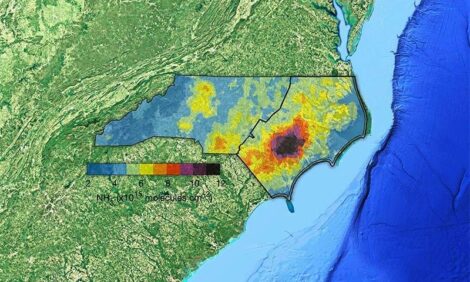



Pork Fat Quality, Iodine Values and Feeding DDGS
Pig meat processors are focusing on carcass fat quality by determining iodine value, according to Tom Guthrie, Extension Educator in Jackson, Colorado and Dale W. Rozeboom, Extension Specialist at Michigan State University's Department of Animal Science in the latest issue of MSU Pork Quarterly.The inclusion of distiller’s co-products in swine rations has been researched for more than a half a century. More recently, research in regard to feeding Distillers Dried Grains with Solubles (DDGS) to pigs has focused on the nutrient concentration, nutrient digestibility, feeding value and potential effects on carcass composition and quality. Due to high commodity prices, pork producers have faced the challenge of trying to lower ration costs. Producers are caught between the rock and the hard spot, as traditional corn and soybean feed prices increase and DDGS is economically justified in swine diets at greater amounts.
DDGS is one of the most abundant and competitively-priced alternative feedstuff available to pork producers. The feeding of amounts greater than 15 to 20 per cent may be reasonable based on dollars and on growth performance. Bergstrom and others (2009) reported that feeding 60 per cent DDGS for about 80 per cent of the grow-finish period was part of the regimen which provided the greatest net income. Cromwell and co-researchers on the North Central Coordinating Committee on Swine Nutrition (NCCC-42; 2011) stated that up to 45 per cent of a high-quality DDGS can be included in diets with very little effect on pig growth performance. They cautioned that to utilise these greater amounts of DDGS efficiently, diets need to be formulated on a standard ileal digestible amino acid basis using supplements of synthetic lysine and tryptophan, which keep the dietary protein concentration from being excessive.
Table 1 below summarises the changes in performance reported in recent studies where 30 per cent or more DDGS have been included in the diet of hogs throughout the finishing period.

Inclusion of DDGS in swine finishing rations may have an impact on carcass fat quality. These carcass quality factors include the slice-ability of bellies for bacon, an oily appearance in the retail package and reduced shelf life. Therefore, in order to meet customer expectations, swine processors are putting an emphasis on carcass fat quality by focusing on determining iodine values of pork fat.
Iodine value (IV) can be used as an indicator of overall fat firmness. This measurement estimates the amount of unsaturation present in the fatty acids present in carcass fat. Unsaturated fatty acids are less firm or categorised as ‘softer’. Iodine values are reported on grams per 100 gram basis (DeRouchey et al., 2010). Typically, a lower value is more ideal and would indicate that there are more saturated fatty acids present in the carcass composition. Furthermore, respective packing plants have currently set IV thresholds ranging from 72 to 74. The jury is still out. The strength of the relationship of IV to pork belly attributes is being debated in packing and in research (Cromwell and Rentfrow, 2011).
DDGS is an excellent addition to swine diets in all phases of pork production in regard to energy and digestible phosphorus. However, a high concentration of linoleic acid in the oil of DDGS causes carcass fat to become softer and therefore resulting in IV’s that are not acceptable (Stein and Shurson 2009). Numerous research reports have indicated that carcass fat composition is affected by dietary ingredients and the fatty acid composition that is fed.
A NCCC-42 collaborative study reported by Cromwell and others (2011) evaluated moderate to high inclusion rates of DDGS in growing-finishing swine diets to determine the effect of carcass quality and belly firmness of swine. This study involved nine research stations, 560 crossbred pigs and a common source of DDGS from a single plant. The average beginning weight of pigs across research stations was 72lb and ended with an average weight of 266lbs. Results of this study as it relates to iodine values are presented in Table 2. DDGS inclusion rates of 13 and 22 per cent result in IV’s of 70 and 74, respectively.

Iodine values vary among studies. In contrast to those values in Table 2, Benz et al. (2010) reported IVs 70.2, 71.5, 72.4, 73.3 and 74.5 when 0, 5, 10, 15 and 20 per cent dietary DDGS were fed, respectively. Cromwell and Rentfrow (2011) reported an IV of 60.9 in carcasses of hogs feed 0 per cent DDGS (lower than Benz et al. (2010) and NCCC-42; Table 2). Bergstrom and others (2009) reported an IV of 81.7 when 60 per cent of the diet was DDGS (lower than 45 per cent as reported by NCCC-42; Table 2).
DDGS Withdrawal Regimens
Removing DDGS late in the finishing phase, a portion or all, is one strategy to lower pork fat IV and achieve acceptable pork fat quality when pigs are fed DDGS at greater inclusion rates earlier in grow-finish.
A study conducted at Michigan State University by Hill et al., (2008), indicated that feeding well balanced commercial swine diets with 20 to 30 per cent DDGS results in acceptable performance and carcasses when DDGS were removed from the diet 30 days prior to harvest.
Ulrey and coworkers (2010) fed 45 per cent DDGS throughout finishing and compared it to diets containing corn and soybean meal only and withdrawal of all DDGS for two and four weeks pre-slaughter, respectively. Iodine values were 60.9, 78.8, 74.3, and 70.4 for the corn, soybean meal only, the continuous 45 per cent DDGS throughout finishing, the two-week withdrawal and the four-week withdrawal regimens, respectively.
Bergstrom and others (2009) fed 60 per cent DDGS throughout most of the grow-finish period, switching to 20 per cent in the last three weeks but did not achieve an IV of 70 or less.
In Table 3 is a summary of two studies that compared fat quality from pigs fed a typical corn, soybean meal ration with no DDGS to pigs fed 30 per cent DDGS in the finishing ration. All DDGS was removed from the ration, for varying lengths of times, before harvest. Fat quality was sampled at different locations on the pork carcass. Withdrawal of all the DDGS from the finishing diet did not totally decrease IV’s to those observed when 0 per cent DDGS was fed throughout the finishing phase. From these and other studies, we also know that leaving small amounts of DDGS in the diet during the withdrawal period lessens the reduction of IV. Finally, these studies indicate that the best DDGS feeding-withdrawal strategy to meet IV thresholds is still not clear.

Conclusions
DDGS will be available for feeding swine and the cost of corn and other ingredients will encourage producers to do so. Packers and processors will continue to evaluate product manufacturing and finished product quality.
Iodine value is the measure currently being discussed as the most useful indicator of fat quality. Expect research to find more accurate fat quality measures which will allow for better precision of inclusion of DDGS in feeding strategies.
In the meantime, completely withdrawing DDGS from the diet at least three weeks before harvest is the surest approach to achieving IVs currently being sought by packers. Producers should also evaluate all other feed ingredients in the diet to determine if they, like DDGS, are providing pigs unsaturated fats and contributing to undesirable pork fat quality.
References
Benz, J.M., S.K. Linneen, M.D. Tokach, S.S. Dritz, J.L. Nelssen, J.M. DeRouchey, R.D. Goodband, R.C. Sulabo and K.J. Prusa. 2010. Effects of dried distillers grains with solubles on carcass fat quality of finishing pigs. J. Anim. Sci. 88: 3666-3682.
Bergstrom, J.R., M.D. Tokach, S.S. Dritz, J.L. Nelssen, J.M. DeRouchey and R. D. Goodband. 2009. Effects of feeder design, gender, and dietary concentration of dried distillers grains with solubles on the growth performance and carcass characteristics of growing-finishing pigs. Swine Day Report of Progress 1020, Kansas State University, Agricultural Experiment Station and Cooperative Extension Service. p252-261.
Cromwell, G.L. and G. Rentfrow. 2011. DDGS in swine diets – does it impact processing of cured bellies and eating quality of port? Proceedings of Midwest Swine Nutrition Conference, September 8, Indianapolis, IN.
Cromwell, G.L., M.J. Azain, O. Adeola, S.K. Baidoo, S.D. Carter, T.D. Crenshaw, S.W. Kim, D.C. Mahan, P.S. Miller and M.C. Shannon. 2011. Corn distillers grains with solubles in diets for growing-finishing pigs: A cooperative study. J. Anim. Sci. 89: 2801-2811.
DeRouchey, J., M. Tokach, S. Dritz, B. Goodband and J. Nelssen. 2010. Iodine value and its impact on pork quality. Kansas Swine Profitability Conference, Kansas State University. Article found on ThePigSite.com
Hill., G.M., J.E. Link, D.O. Liptrap, M.A. Gieseman, M.J. Dawes, J.A. Snedegar, N.M. Bello and R.J. Tempelman. 2008. Withdrawal of distillers dried grains with solubles (DDGS) prior to slaughter in finishing pigs. J. Anim. Sci. 86 (Suppl. 2): 52. (Abstr.)
Jacela, J.Y., J.M. Benz, S.S. Dritz, M.D. Tokach, J.M. DeRouchey, R.D. Goodband, J.L. Nelssen, and K.J. Prusa. 2009. Effect of dried distillers grains with solubles withdrawal regimens on finishing pig performance and carcass characteristics. Swine Day Report of Progress 1020, Kansas State University, Agricultural Experiment Station and Cooperative Extension Service. p181-191.
Stein, H.H., and G.C. Shurson. 2009. Board-Invited Review: The use and application of distillers dried grains with solubles in swine diets. J. Anim. Sci. 87: 1292-1303.
Ulery, M.C., G.L. Cromwell, G.K. Rentfrow, M.D. Lindemann and M.J. Azain. 2010a. Attempts to improve belly firmness in finishing pigs fed a high level of DDGS. J. Anim. Sci. 88:(E-Suppl. 3):91.
Ulery, M.C., G.L. Cromwell, G.K. Rentfrow, M.D. Lindemann and M.J. Azain. 2010b. Belly firmness and bacon quality from finishing pigs fed DDGS with various withdrawal times and with added tallow. J. Anim. Sci. 88:(E-Suppl. 2):553.
Xu, G., S.K. Baidoo, L.J. Johnston, D. Bibus, J.E. Cannon and G.C. Shurson. 2010. The Effects of feeding diets containing corn distillers dried grains with solubles, on growth performance and pork quality in grower-finisher pigs. J. Anim. Sci. 88: 1388-1397.
December 2011







